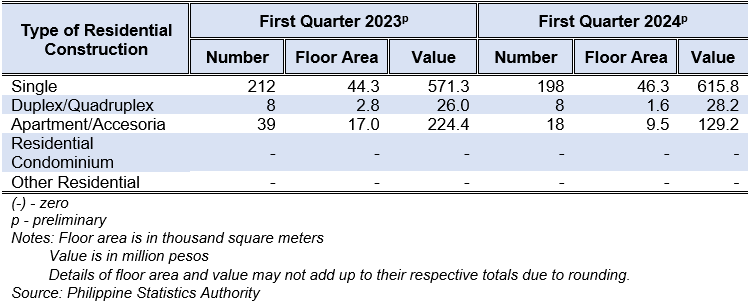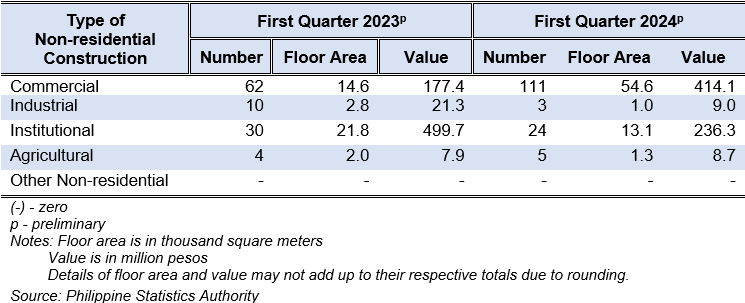Number of building permits declines by 7.1%
The number of approved building permits in the Cordilleras reached 391 in the first quarter of 2024. This was less than 30 permits compared to the same quarter of the previous year, or a decrease of 7.1%.
Meanwhile, the covered floor area went up to 129.1 thousand square meters. This corresponds to a 13.3% increment equal to 15.1 thousand square meters. However, its value decreased to PhP1.5 billion, reflecting a decrease of 9.3% equivalent to PhP152.2 million (Table 1).
Residential buildings records highest number of constructions
During the first quarter of 2024, the number of residential constructions in the region had the highest number with 224. This indicated a 13.5% decline from the same quarter the previous year, which was equivalent to 35 less permits. The same pattern was noted at the national level with 27,489 permits approved, representing a 10.1% decrease or equivalent to 2,790 less construction permits.
This was followed by non-residential construction with 143 approved permits, 37 permits more compared to same period the previous year or equivalent to 34.9% increase. Alteration and repair came third with 15 constructions, and addition came fourth with 9 constructions (Table 1).
Residential buildings posts greatest construction value
In the first quarter of 2024, the value of construction in the Cordilleras contributed 1.4% to the national value which accounted for PhP1.5 billion. It declined by 9.3% or equal to a decrease of PhP152.2 million.
Among all construction types, residential construction made up the largest portion equal to 52.4% with total value of PhP773.2 million. This was followed by non-residential construction valued at PhP668.1 million. Meanwhile, alteration and repair contributed the least with PhP16.3 million (Table 1).
Non-residential constructions account for more than half of total floor area
The region’s total covered floor area of approved building permits in the first quarter of 2024 was 129.1 thousand square meters. This corresponds to an increase of 13.3% and was 12.3 percentage points higher than the growth rate in the entire Philippines.
Non-residential permits recorded a total floor area of 70.1 thousand square meters, equivalent to 54.3% of the total floor area and an increase of 70.1% compared to the same period the previous year from an area of 28.9 thousand square meters.
Meanwhile, residential construction recorded a floor area of 57.4 thousand square meters. This had an annual decrement of 10.5%, equal to 6.7 thousand square meters (Table 1).
Table 1. Summary of Construction Statistics from Approved Building Permits, by Type, Philippines and Cordillera Administrative Region: First Quarter 2023 and 2024

Single houses have highest number of constructions, floor area covered, and construction value
Single house constructions posted the highest in terms of number of constructions, floor area covered, and construction value. A total of 198 approved permits were recorded in the first quarter of 2024. Approved permits were down by 14, equivalent to a decrease of 6.6%.
For floor area covered, single house construction posted 46.3 thousand square meters. This reflected an increase of 4.3%, equivalent to 2.0 thousand square meters. Likewise, the value for the single house construction registered the greatest with PhP615.8 million which was an increase of 7.8% or an additional PhP44.5 million worth of construction value (Table 2 and Figure 1).
Apartment/Accesoria posts lower number of constructions, floor area covered, and construction value
In the first quarter of 2024, apartment/ accesoria type of residential construction went down in terms of number, floor area, and value. There were 18 approved building permits with this type of residential construction with a total of 9.5 thousand square meters and valued at PhP129.2 million.
The number of duplex/quadruplex type of residential constructions remained at 8. However, it notably declined in floor area by 42.1%, from 2.8 thousand square meters in the first quarter of 2023 to 1.6 thousand square meters in the first quarter of 2024. Nevertheless, the value of production increased by 8.4%, from PhP26.0 million to PhP28.2 million (Table 2 and Figure 1).
Table 2. Residential Construction by Type, Cordillera Administrative Region:
First Quarter 2023 and 2024

Figure 1. Residential Construction Growth Rates by Type, Cordillera Administrative Region: First Quarter 2023p and 2024p
(In Percent)

Commercial buildings records higher number of constructions, floor area covered, and construction value
In the first quarter of 2024, a total of 111 commercial building permits were approved, which was an increase of 79.0% from the same quarter the previous year. Likewise, the floor area increased 54.6 thousand square meters which was 40.0 thousand square meters more than the previous year. In terms of value, the constructions were valued at PhP414.1 million, an increase of 133.4% equivalent to PhP236.7 million (Table 3 and Figure 2).
Industrial and Institutional constructions decrease
The number of industrial buildings dropped to three (3) during the first quarter of 2024 or a decrease of 70%. Consequently, floor area and value declined by 63.4% and 57.6%, respectively.
Similarly, institutional buildings went down to 24 or by 20.0%. The floor area covered by these permits was 13.1 thousand square meters and was valued at PhP236.3 million (Table 3 and Figure 2).
Agricultural buildings increase
From four (4) agricultural buildings in the first quarter of 2023, this increase by 25.0% or a total of five (5) during this year’s first quarter. This covered a smaller floor area with 13.1 thousand square meters with an estimated value of PhP8.7 million.
Table 3. Non-residential Construction by Type, Cordillera Administrative Region:
First Quarter 2023 and 2024

Figure 2. Residential Construction Growth Rates by Type, Cordillera Administrative Region: First Quarter 2023p and 2024p
(In Percent)

(SGD)
VILLAFE P. ALIBUYOG
Regional Director
AFRB/RJPA/JPL
Technical Notes
Building permit is a written authorization granted by the LBO to an applicant allowing him to proceed with the construction of a specific project after plans, specifications, and other pertinent documents have been found to be in conformity with the National Building Code (PD 1096).
Building refers to any independent, free-standing structure comprised of one or more rooms or other spaces, covered by a roof and enclosed with external walls or dividing walls, which extend from the foundation to the roof.
Construction refers to all on-site work done from site preparation, excavation, foundation, assembly of all the components and installation of utilities, machineries, and equipment of buildings/structures.
Residential building is a building for which its major parts or more than half of its gross floor area is built for dwelling purposes. This type of building can be of the single type, duplex, apartment and/or accessoria, and residential condominium.
Single house is a complete structure intended for a single family or household, i.e., bungalow, 2-storey house, nipa hut, etc.
Duplex house is a structure intended for two households, with complete living facilities for each; it is a single structure divided into two dwelling units by a wall extending from the floor to the ceiling.
Apartment is a structure, usually of two storeys, made up of independent living quarters, with independent entrances from internal walls and courts.
Accesoria is a one or two-floor structure divided into several dwelling units, each dwelling unit having its own separate entrance from the outside.
Residential condominium is a structure, usually of several storeys, consisting of multiple dwelling units.
Other residential construction consists of school or company staff houses, living quarters for drivers and maids, and guardhouses.
Non-residential building includes commercial, industrial, agricultural, and institutional buildings.
Commercial buildings refer to office buildings and all buildings which are intended for use primarily in wholesale, retail, and service trades, i.e., stores, hotels, restaurants, banks, disco houses, etc.
Industrial buildings are buildings used to house the production, assembly, and warehousing activities of industrial establishments, i.e., factories, plants, mills, repair shops, machine shops, printing press, storage plants, electric generating plants.
Institutional buildings are buildings which primarily engaged in providing educational instructions and hospital/health care, ports, airports and other government buildings, i.e., schools, museums, libraries, sanitaria, churches, hospitals.
Agricultural buildings are buildings used to house livestock, plants, and agricultural products such as barns, poultry houses, piggeries, stables, greenhouses, and grain mills.
Other non-building constructions include cemetery structures, street furniture, waiting sheds, communication towers, etc.
Addition refers to any new construction which increases the height or area of an existing building/structure.
Repair is a remedial work done on any damaged or deteriorated portion/s of a building/structure to restore its original condition.
Renovation is any physical change made on structures to increase their value and quality.
Alteration is a construction in a building/structure involving changes in the materials used, partitioning and location/size of openings, structural parts, existing utilities, and equipment but does not increase the overall area thereof.
Conversion is a change in the use or occupancy of structure or any portion thereof, which has different requirements.
Demolitions refer to the systematic dismantling or destruction of a building/structure, in whole or in part.
Street furniture are street structures consisting of monuments, waiting sheds, benches, plant boxes, lampposts, electric poles, and telephone poles.
Floor area of building refers to the sum of the area of each floor of the building measured to the outer surface of the outer walls including the area of lobbies, cellars, elevator shafts, and all communal spaces in multi-dwellings. Areas of balconies are excluded.
Total value of construction refers to the sum of the cost of building, electrical, mechanical, plumbing, and others. The value is derived from the approved building permit and represents the estimated value of the building or structure when completed.

